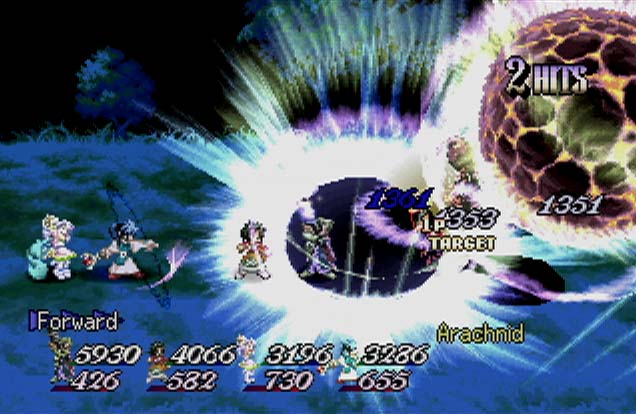|
|

|
BATTLE SYSTEM
|

|
INTERACTION
|

|
ORIGINALITY
|

|
STORY
|

|
MUSIC & SOUND
|

|
VISUALS
|

|
CHALLENGE
|
Adjustable
|
COMPLETION TIME
|
20-30+ Hours
|
|
OVERALL
4.0/5
|
Rating definitions
|
|
|
Eternia is a world consisting of two planets: Inferia and Celestia, which are separated by a forcefield known as the Orbus Barrier. A girl from Celestia named Meredy travels by spaceship to Inferia, bringing news of an impending event known as the Grand Fall, when both planets collide. Two friends, Reid and Farah, discover Meredy when she crashes on Inferia, and will travel their world to see if they can stop the Grand Fall from occurring. Namco's Tales of Eternia is the third game in their Tales series, localized to North America, unfortunately, as Tales of Destiny II, which would be the title of the real direct sequel to Tales of Destiny. In spite of this idiotic name-changing decision, the game itself proves to be fairly enjoyable.
Like other games in the series, Eternia features randomly-encountered real-time battles, with the player's characters and enemies battling on a 2-D field and the player controlling one character and the A.I., or up to three additional players, controlling the others. Party A.I., however, is actually fairly decent in this installment, with a variety of adjustable options existing in the menus, and the player can assign ally skills to the L2 and R2 buttons for easier access in the heat of battle. Players can also chain combos against enemies, with added bonus experience at the end of battle depending upon the maximum number of hits the player achieves against the enemy.
Eternia's two primary magicians, Meredy and Keele, both have Craymel Cages, into which the player can place Craymels, summon spirits gained sporadically during the main storyline, for use of various magic spells depending upon the Craymels' placement in the cages, and which either spellcaster can summon into battle after the Craymels' vitality gauges are full. Craymels gain experience and additional spells alongside the main characters after battles, which normally average a little over twenty seconds. Overall, the battle system, as with most installments of the Tales franchise, is a main draw to the game, with few shortcomings of which to speak aside from some minor flaws with the semi-auto targeting system, which can occasionally falter.
 Reid makes PETA mad
Reid makes PETA mad
|
|
The interface is pretty clean for the most part, with easy menus and controls, and a good idea on how to advance the main storyline, with the player, on the overworld, able to get a voice-acted reminder on where to go next. Eternia also features an always-convenient save-anywhere feature, though when resuming his or her game, the player will begin at a save crystal if within a dungeon. As with the battle system, there isn't much to complain about, with only minor flaws such as the inability to skip cutscenes.
Being a sequel in a growing series, Eternia naturally borrow some elements such as real-time combat, and even summon spirits, from its predecessors, although it does have some unique ideas of its own such as the Craymel Cage system and by extent the storyline's idea of a world consisting of two planets.
Most Tales games don't have spectacular stories, and Eternia is unfortunately no exception. The plot essentially consists of wandering from place to place to collect summon spirits and avert disaster, with little sense of suspense or even opposition to the main characters. Granted, there are villains, although they really don't play any significant role in the story until late in the game. The characters do have some development and backstory, and the pacing is decent, and overall, while the plot doesn't detract from the game severely, it certainly isn't reason enough to play it.
 The bouncing ball of doom
The bouncing ball of doom
|
|
Motoi Sakuraba, composer of most installments of the Tales series, returns in Eternia, providing many decent tracks that are hardly out of place and sometimes provide a good ambience. The voice acting sounds stilted at times, yet thankfully doesn't detract too greatly from the game, and all in all, Eternia is fairly easy on the ears.
Eternia is also easy on the eyes, featuring beautiful anime-styled visuals with colorful scenery, well-animated sprites, some decent FMVs, and the rare anime cutscene. Granted, some dungeons do have a habit at times of reusing exactly the same scenery for different rooms, though this is an otherwise minor flaw in an excellent-looking game.
Finally, Eternia is not a terribly lengthy game, taking somewhere from twenty to thirty hours to complete, with a replay mode allowing for a higher difficulty level and an extra dungeon. Overall, Tales of Eternia is one of the more enjoyable titles on the Sony Playstation, with a solid combat system, controls, graphics, and music. While the Playstation version has somewhat fallen off the mainstream gaming market, Playstation Portable owners can import a European-released port of the game. Regardless of system, however, Eternia is a solid experience worthy of the Tales name.
Review Archives
|









